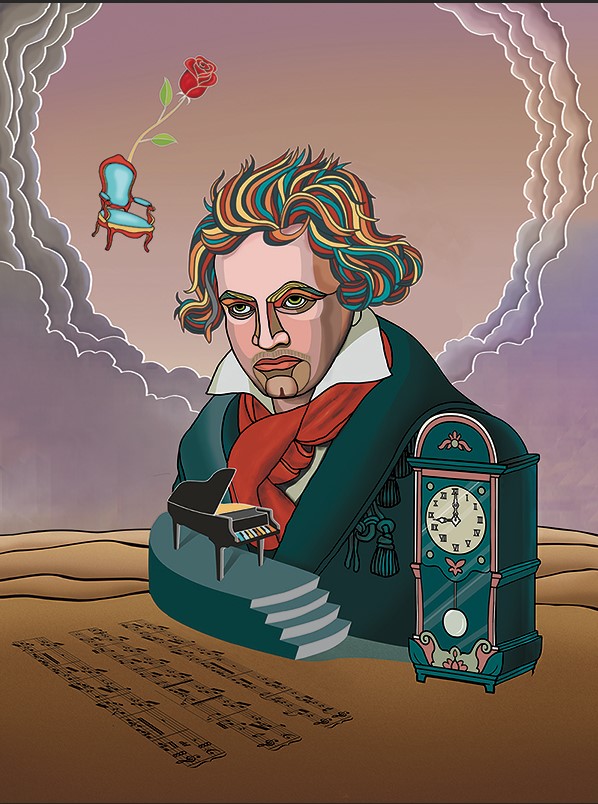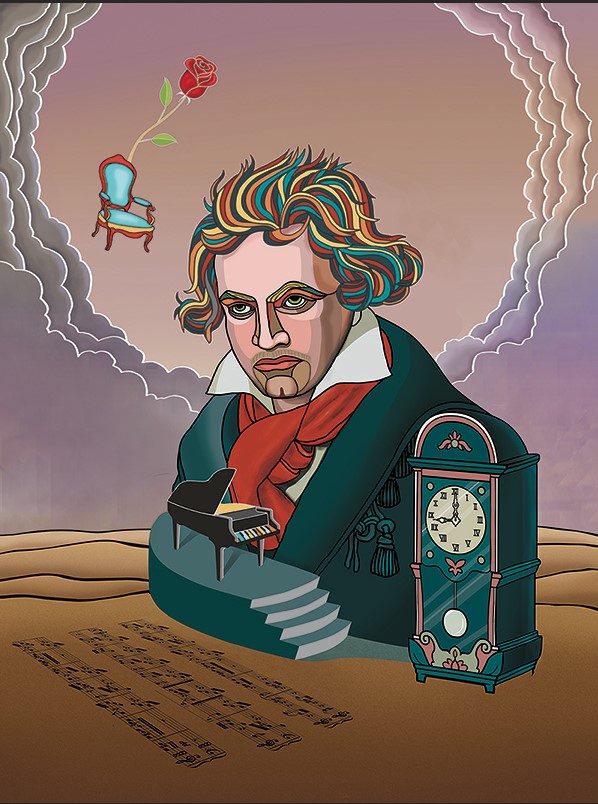
Assist. Prof. Jinabhadr Kantaputra

Abstract :
The “Creative Digital Art Painting Design Project: The World’s Composer of the Classical Era” introduces a pioneering approach to connecting music and visual art through digital media. This innovative project focuses on creating two digital images: one is the portrait of an iconic composer—Ludwig van Beethoven from the Classical era. This portrait is inspired by his musical compositions and infused with surrealism and mannerism, drawing from 18th-century art styles. Another one is created by exploring abstract representations of musical instruments, influenced by Beethoven’s Für Elise, and incorporates cubism, echoing the influence of Pablo Picasso’s modernist works.
The project is set within the context of Rangsit University College of Music, Thailand’s first private institution to offer a Bachelor of Music program, established in 2002. Its ” SURYADHEP MUSIC SALA,” with a seating capacity of 1,100, provides a beautiful and acoustically enriching space for faculty, students and visitors. By translating the sound of music into tangible forms through impressive digital artwork, this project seeks to enhance the atmosphere of the College of Music. The artworks, reflecting both classical and modern artistic styles, will serve to increase the institution’s aesthetic environment, bringing its halls, classrooms, and practice rooms with joy and beauty, while celebrating the rich heritage of music history.
Objectives :
1. To create digital art media that connects with music, presenting the personality and identity of the European composer Beethoven in the Classical era.
2. To convey digital art in the context of classical music, inspired by the piece Für Elise.
3. To enhance the atmosphere with joy, promoting music learning.
4. To create works that have identity and uniqueness for the College of Music, Rangsit University.
Conceptual Framework :
The concept behind the creative design of a portrait of Ludwig van Beethoven is inspired by the piece Für Elise from the Classical era and incorporates elements from the paintings of artist Salvador Fellip Jacint Dalí, who is known for Surrealism Art. This style is applied in the late Renaissance period.
Process / Methodology :
- Study the history of the College of Music.
- Visit the College of Music to study the suitable areas for artwork installation.
- Visit the Museum of Contemporary Art (MOCA) to find inspiration.
- Study the history of the world-renowned composer Ludwig van Beethoven during the Classical period.
- Study popular music from the Classical era, choosing Beethoven’s “Fur Elise” as a source of inspiration.
- Study Surrealism art from the late Renaissance period, Mannerism art in the 18th century, and Cubism during the Modern Art period.
- Imagine music as a visual concept, interpret it as a mental image, and then sketch that image onto paper.
- Consult with an advisor for feedback and revisions.
- Review the use of Adobe Illustrator for drawing and Adobe Photoshop for coloring to find the most suitable techniques for creating the artwork.
- Create the design on the computer by tracing the draft in Adobe Illustrator, then color and apply gradient techniques to different shapes using Adobe Photoshop.
Techniques and Materials :
The Adobe Illustrator software is used for drawing outlines, and Adobe Photoshop is used for coloring, in order to explore suitable techniques for creating the artwork.
Result / Conclusion :
- A creative digital illustration is created as a new design approach.
- Faculty and students of the College of Music are inspired and enjoy their music practice.
- To create a more beautiful atmosphere at the College of Music at Rangsit University, leaving a positive impression on visitors.
References :
Biography.com Editors, (2024, Jul 17) Ludwig van Beethoven. Biography. https://www.biography.com/musicians/ludwig-van-beethoven
Tonara Team, (202O, October 6) The History of Fur Elise. Tonara. https://www.tonara.com/blog/history-of-fur-elise/
James Voorhies, (2004, October 1) Surrealism. The Metropolitan Museum of Art. https://www.metmuseum.org/essays/surrealism
Michael and Deborah Clarke, (2012) A-level: A beginner’s guide to Mannerism. smarthistory.org. https://smarthistory.org/a-beginners-guide-to-mannerism-2/
Dr. Charles Cramer and Dr. Kim Grant, (2019, November) Cubism and multiple perspectives. smarthistory.org. https://smarthistory.org/cubism-and-multiple-perspectives/